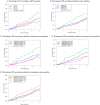The impact of platelet indices on clinical outcome in heart failure: results from the MyoVasc study
- PMID: 33939298
- PMCID: PMC8318485
- DOI: 10.1002/ehf2.13390
The impact of platelet indices on clinical outcome in heart failure: results from the MyoVasc study
Abstract
Aims: Platelet indices have been associated with traditional cardiovascular risk factors, cardiovascular diseases and all-cause mortality. This study aimed to investigate the role of platelet count, mean platelet volume (MPV) and platelet-to-leukocyte ratio, including platelet-to-monocyte and platelet-to-lymphocyte ratio with cardiac function, heart failure (HF) phenotypes and clinical outcome, worsening of HF.
Methods and results: Univariate and multivariable linear and Cox regression analyses were used to investigate the associations between platelet indices, cardiac function and worsening of HF in 3250 subjects enrolled in the MyoVasc study. Higher MPV, lower platelet count, lower platelet-to-leukocyte and platelet-to-monocyte ratios have been associated with reduced left ventricular ejection fraction (beta estimate [β]MPV [fL] = -0.05 [-0.09; -0.02], βplatelet count (× 10/L)9 = 3.4 [1.2; 5.6], βplatelet-to-leukocyte ratio = 1.4 [1.1; 1.8], βplatelet-to-monocyte ratio = 28 [20; 36]) and increased E/E' ratio (β MPV [fL] = 0.04 [0.003; 0.07], βplatelet count (× 10/L)9 = -3.1 [-5.3; -0.92], βplatelet-to-leukocyte ratio = -0.83 [-1.2; -0.46], βplatelet-to-monocyte ratio = -20 [-28; -12]), independent of age and sex. Cox regression demonstrated an increased risk for worsening of HF in subjects with MPV > 75th percentile (hazard ratio [HR] = 1.47 [1.16; 1.87]), platelet count < 25th percentile (HR = 1.36 [1.07; 1.74]), platelet-to-leukocyte < 25th percentile (HR = 1.53 [1.20; 1.95]), platelet-to-monocyte < 25th percentile (HR = 1.38 [1.08; 1.77]) and platelet-to-lymphocyte > 75th percentile (HR = 1.50 [1.17; 1.93]) ratios, independent of potential confounders. MPV > 75th percentile and platelet count < 25th percentile were strongly related to outcome in HFpEF vs. HFrEF (P for difference = 0.040). Platelet-to-leukocyte ratios were associated with worse outcome in both HF phenotypes, without a significant difference between HFpEF and HFrEF.
Conclusions: Platelet indices are linked with worse cardiac function and adverse clinical outcome, independent of subjects' underlying cardiovascular profile. This study emphasizes their important value to provide additional information on pathophysiology and risk stratification in HF syndrome.
Keywords: Heart failure; Mean platelet volume; Platelet count; HFrEF; HFpEF; Worsening of heart failure.
© 2021 The Authors. ESC Heart Failure published by John Wiley & Sons Ltd on behalf of European Society of Cardiology.
Conflict of interest statement
The remaining authors declare no competing interests.
Figures


References
-
- Chung I, Goyal D, Macfadyen RJ, Lip GY. The effects of maximal treadmill graded exercise testing on haemorheological, haemodynamic and flow cytometry platelet markers in patients with systolic or diastolic heart failure. Eur J Clin Invest 2008; 38: 150–158. - PubMed
-
- Yancy CW, Jessup M, Bozkurt B, Butler J, Casey DE Jr, Drazner MH, Fonarow GC, Geraci SA, Horwich T, Januzzi JL, Johnson MR, Kasper EK, Levy WC, Masoudi FA, McBride PE, McMurray JJ, Mitchell JE, Peterson PN, Riegel B, Sam F, Stevenson LW, Tang WH, Tsai EJ, Wilkoff BL. 2013 ACCF/AHA guideline for the management of heart failure: a report of the American College of Cardiology Foundation/American Heart Association Task Force on practice guidelines. Circulation 2013; 128: e240–e327. - PubMed
-
- Lee DS, Gona P, Vasan RS, Larson MG, Benjamin EJ, Wang TJ, Tu JV, Levy D. Relation of disease pathogenesis and risk factors to heart failure with preserved or reduced ejection fraction: insights from the framingham heart study of the national heart, lung, and blood institute. Circulation 2009; 119: 3070–3077. - PMC - PubMed
Publication types
MeSH terms
LinkOut - more resources
Full Text Sources
Other Literature Sources
Medical
Research Materials
Miscellaneous

